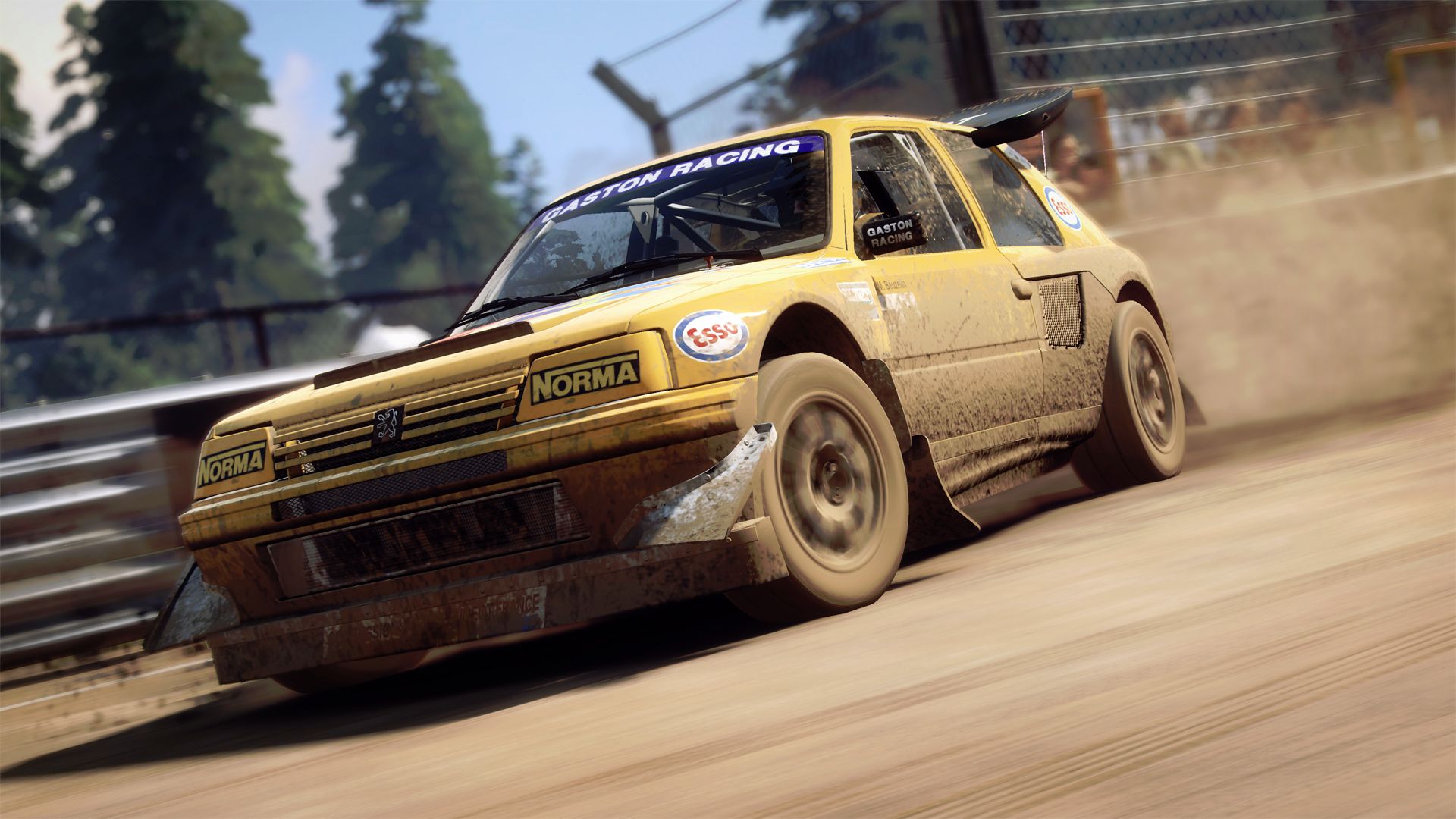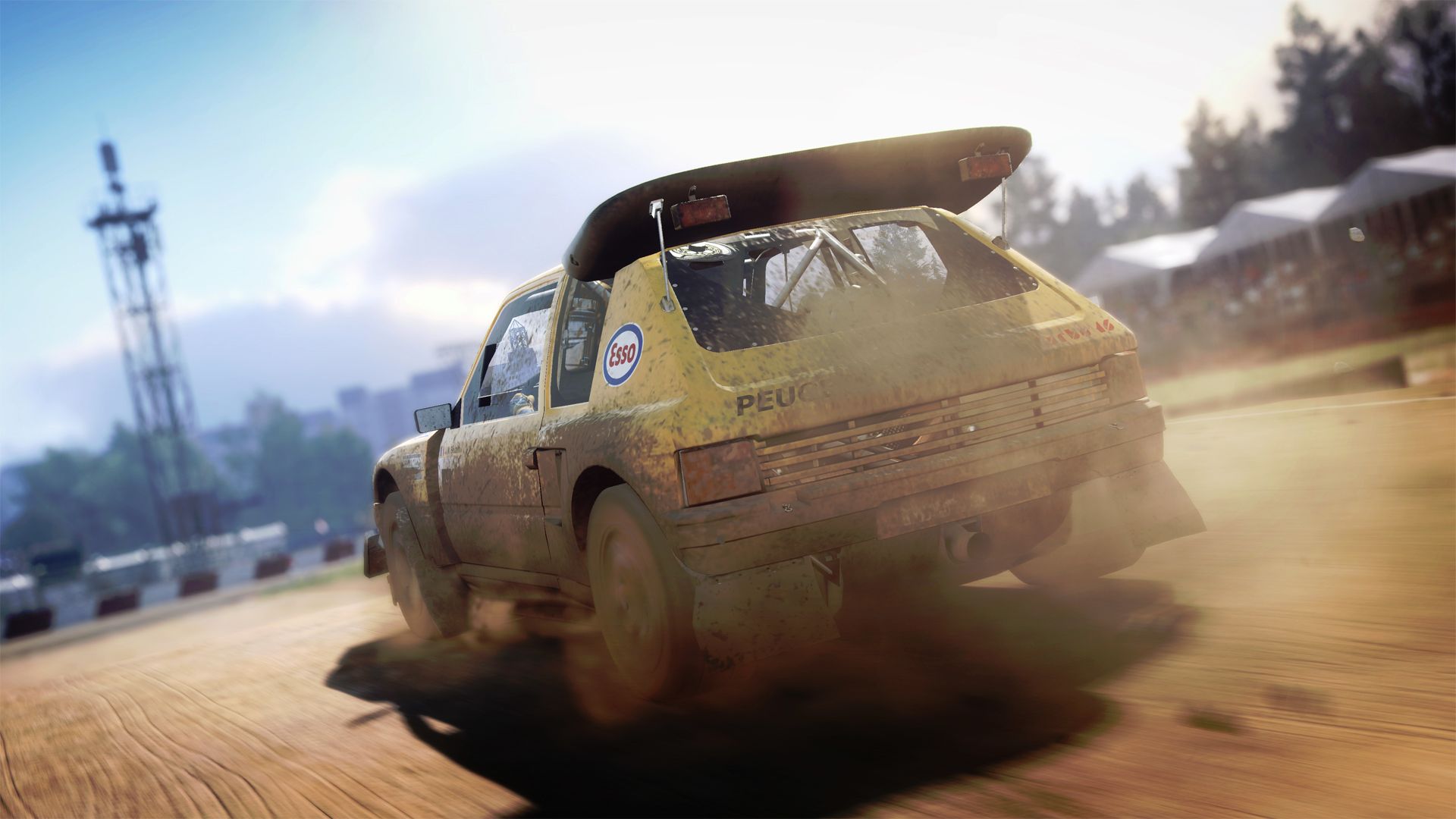DiRT Rally 2.0: Peugeot 205 T16 Rallycross
BUY DiRT Rally 2.0: Peugeot 205 T16 Rallycross
Click the button below to purchase DiRT Rally 2.0: Peugeot 205 T16 Rallycross.
The Peugeot 205 T16 Rallycross DLC for DiRT Rally 2.0 was developed and published by Codemasters, a studio renowned for its expertise in racing simulations. Released in 2019, this DLC added the rallycross version of the legendary Peugeot 205 Turbo 16 to the game’s vehicle roster. The car, originally a dominant force in Group B rallying during the 1980s, was later adapted for rallycross competition, bringing its explosive power and compact design to short-format racing. Its inclusion in DiRT Rally 2.0 expanded the game’s FIA World Rallycross Championship lineup with a historic and high-performance machine.
The DLC features the Peugeot 205 T16 Rallycross with detailed modeling and performance characteristics that reflect its real-world rallycross adaptation. With a mid-engine layout, four-wheel drive, and turbocharged power, the car delivers aggressive acceleration and nimble handling, ideal for the tight corners and mixed surfaces of rallycross circuits. Players can use the vehicle in single-player and multiplayer rallycross events, enjoying its raw speed and distinctive driving dynamics. Its compact frame and rally heritage make it a standout choice for fans of vintage motorsport.
Promotion for the Peugeot 205 T16 Rallycross DLC was part of Codemasters’ ongoing content strategy for DiRT Rally 2.0. The studio announced the car’s release through Steam updates, social media posts, and developer blogs, often bundling it with other seasonal content. Screenshots and gameplay clips showcased the car’s design and performance, emphasizing its legacy and appeal to rallycross enthusiasts. This promotional approach helped maintain player engagement and reinforced the game’s commitment to authenticity and variety.
Reception to the DLC was positive, particularly among players who appreciate classic rally cars and the rallycross discipline. The Peugeot 205 T16 Rallycross was praised for its responsive handling, powerful acceleration, and faithful recreation within the game’s physics engine. While the DLC didn’t introduce new gameplay mechanics, its historical significance and competitive edge made it a welcome addition. The car’s blend of rally pedigree and rallycross adaptation contributed to DiRT Rally 2.0’s reputation as one of the most immersive and comprehensive racing simulations available.
Peugeot 205 T16 In Depth
Introduction
The Peugeot 205 Turbo 16 is a mid-engined, four-wheel-drive rally car developed by Peugeot Talbot Sport for Group B competition in the early 1980s and a homologation road car produced in limited numbers to satisfy FIA requirements. The T16 transformed the 205 nameplate into a purpose-built competition machine that shared only a handful of body items with the production 205, notably the windscreen, doors and some lighting units. The project aimed to deliver a compact, high-performance car capable of winning World Rally Championship events and regaining Peugeot’s motorsport standing after modest factory involvement in top-level rallying. The 205 T16 combined a tubular spaceframe, a transverse mid-mounted turbocharged engine, and full-time four-wheel drive to maximise traction and agility on loose surfaces. Peugeot rapidly developed competition and road-going variants to meet the Group B homologation requirement of 200 examples within the stipulated timeframe. The result was one of the era’s most effective and influential rally cars, achieving rapid competitive success and strong technical acclaim.
Origins and Development
Peugeot initiated the T16 programme in response to the FIA’s Group B regulations introduced in 1982 that encouraged manufacturers to build highly specialised rally cars with a modest 200-unit homologation requirement. Peugeot Talbot Sport under Jean Todt and lead engineers designed a car that would exploit the rules with a mid-engine, four-wheel-drive layout that maximised packaging and traction for special stages. Development moved quickly from concept to competition with intense collaboration between Peugeot’s factory team and specialist suppliers for chassis, engine and transmission components. The goal was to create a compact competitor that could outperform larger, traditional rally cars through superior power-to-weight ratio and cornering balance. Early development focused on producing both an effective competition prototype and a road-legal homologation version to satisfy FIA scrutiny and support the team’s championship ambitions. The programme’s urgency and clear competitive brief shaped many of the car’s radical design choices and rapid development cycles.
Design and Chassis
The 205 T16 employed a tubular steel spaceframe chassis with composite and lightweight body panels to achieve high torsional stiffness and low weight suited to rally competition. The bodywork was heavily revised from the production 205 with extended wheelarches, large roof and side air intakes, and a wide, aggressive stance to house the broader track and cooling requirements of a mid-engined layout. Suspension geometry was developed for rallying with long travel and robust components to endure gravel and rough stages while retaining precision on tarmac tests. The car’s transverse mid-engine placement and compact packaging concentrated mass centrally and low for improved rotational response and agility through tight, technical rally sections. Cooling and intercooling ducts were integrated into the bodywork to handle the demands of turbocharged competition engines, and aerodynamic treatments on later Evolutions were refined to improve high-speed stability. The design philosophy prioritised serviceability, visibility for mechanics, and modular repairability during fast rally service intervals.
Engine and Drivetrain
The 205 T16 used a transverse, turbocharged 1.8-litre four-cylinder derived from Peugeot’s XU family with Bosch fuel systems and a KKK turbocharger producing roughly 200 PS in early homologation road form and considerably more in competition trim. Competition Evolutions were developed to raise power substantially, with later Evolution 2 rally cars reputed to exceed 500 bhp in race tune while retaining driveability for stage conditions. Power was transmitted through a five-speed manual gearbox to a permanent four-wheel-drive system with torque distribution and limited-slip differentials engineered specifically for the T16 package. The drivetrain architecture emphasised compactness and robustness to cope with high turbo torque and the varied traction conditions encountered in world championship rallies. Cooling, intake and exhaust routing were tailored to the transverse mid-engine layout with intercooler placement and ducting optimised for both performance and service access. The combined effect of engine response, gearing and four-wheel drive produced an exceptionally quick and tractable rally car across all surfaces.
Evolution Models
Peugeot produced a succession of development iterations for competition, commonly described as Evolution 1 and Evolution 2, each incorporating aerodynamic, cooling and mechanical refinements to increase power, stability and reliability under race conditions. The Evolution 1 introduced wider bodywork, revised suspension and increased engine performance over the initial prototypes, enabling improved competitiveness on the 1985 calendar. The Evolution 2 featured more extreme aero with a pronounced rear wing, larger intakes, reworked cooling, and further engine development; it was aimed at extracting maximum performance for 1986 events and showcased how quickly Group B machinery evolved between seasons. Road-going homologation cars reflected some evolution parts but remained detuned and more amenable to street use while still representing the competition car’s architecture in compact form. These evolutionary steps were driven by both competitive necessity and the rapid technical arms race characteristic of the Group B era. The evolution programme illustrated Peugeot’s commitment to continuous development until the regulatory environment changed in 1987.
Competition Achievements
The 205 T16 achieved rapid success in the World Rally Championship, securing both drivers’ and manufacturers’ titles for Peugeot in 1985 and 1986 and delivering a strong win record across diverse events. Drivers such as Timo Salonen and Juha Kankkunen scored multiple victories in the T16, demonstrating the car’s capability to dominate gravel and mixed-surface rallies against other Group B challengers. The car’s combination of power, light weight and superior traction made it exceptionally quick on loose, technical stages where nimble handling and acceleration out of tight corners determined results. Despite its competitive prowess, the T16’s career was cut short alongside the broader Group B class after the FIA banned the category for 1987 following a series of fatal and serious accidents across the sport. Nonetheless, the 205 T16’s championship successes and stage victories remain central to its reputation as one of the most effective cars of the Group B era.
Technical Specifications
Standard homologation road variants of the 205 T16 were quoted at approximately 200 PS from a 1.8-litre turbocharged XU engine, a curb weight in the region of 1,140 kg depending on specification, and compact external dimensions derived from the 205 footprint but broadened for rally use. Competition specifications varied widely: rally Evolutions ran higher boost, strengthened internals, revised cam profiles and bespoke engine management to deliver several hundred horsepower in race trim while gear ratios, differential settings and suspension were tailored to each event. The car used 15-inch wheels in period competition and a five-speed manual gearbox with specific final drives to balance acceleration and top speed for each stage. Braking systems, cooling capacity and lubrication were upgraded in competition builds to endure prolonged high-load use under rally conditions. The T16’s power-to-weight ratio in race tune placed it among the era’s quickest accelerating rally cars, producing startling acceleration figures in real-world special stages.
Decline of the Programme and Aftermath
The cancellation of Group B for 1987 ended factory development of the 205 T16 as Peugeot and other manufacturers withdrew from the now-proscribed category and redirected resources to safer, production-derived rally classes. Many T16 chassis and parts were retained by privateers, adapted for rallycross, hillclimb and historic competition where regulations and safety environments allowed their continued use. Road-going homologation cars and competition derivatives became collectible, but servicing and parts supply grew fragmented, creating a specialist restoration market and an active community focused on preservation and sympathetic rebuilding. The abrupt regulatory change left unanswered questions about how far the T16’s potential could have been taken with further factory development and uninterrupted competition exposure. Documentation, surviving engineers’ notes and archived race data have supported restorations and historical research, but provenance and exact production totals remain topics of careful archival inquiry among specialists. The programme’s sudden end cemented the T16’s status as an emblem of Group B’s rapid rise and fall.
Legacy and Collectability
The Peugeot 205 T16 is widely regarded as one of Group B’s iconic cars and a high-value collector’s item prized for its competition pedigree, rarity and historical significance in rallying history. Surviving examples appear at major auctions, concours events and museums where their technical ingenuity and dramatic appearance attract significant attention from enthusiasts and historians. The car’s influence persists in rallying lore and in the design lessons it offered about mid-engined packaging, turbocharged performance and compact four-wheel-drive systems for small cars. Dedicated specialists supply reproduction parts and restoration expertise, and thoroughbred competition chassis continue to be campaigned in historic events that celebrate the Group B era. The 205 T16’s championship successes and dramatic story ensure ongoing interest from collectors, researchers and the rally community, preserving its place as a milestone in performance-car and motorsport history.
Related Searches
DiRT Rally 2.0: Peugeot 205 T16 Rallycross Download
DiRT Rally 2.0: Peugeot 205 T16 Rallycross is available to purchase and download from a range of vendors. Always shop....
DiRT Rally 2.0: Peugeot 205 T16 Rallycross Key
There are a wide range of resellers that may offer keys for DiRT Rally 2.0: Peugeot 205 T16 Rallycross. This is often the....
DiRT Rally 2.0: Peugeot 205 T16 Rallycross Review
The Steam store provides a review system enabling you to make an informed choice before buying this....
DiRT Rally 2.0: Peugeot 205 T16 Rallycross Free
DiRT Rally 2.0: Peugeot 205 T16 Rallycross is available to purchase and download from the link shown further up this....
DiRT Rally 2.0: Peugeot 205 T16 Rallycross PlayStation
At the time of publishing, DiRT Rally 2.0: Peugeot 205 T16 Rallycross is available on the PlayStation platform.....
DiRT Rally 2.0: Peugeot 205 T16 Rallycross Xbox
At the time of publishing, DiRT Rally 2.0: Peugeot 205 T16 Rallycross is available on the Xbox platform. There are...







